Uzbekistan
 From Rationalwiki
From Rationalwiki _-_UZB_-_UNOCHA.svg.png)
“”Two suspicious deaths with apparent signs of torture highlight Uzbekistan's brutal ongoing crackdown against independent Muslims... Individuals who had seen one of the bodies told Human Rights Watch that it showed clear signs of torture... Sixty to seventy percent of the body was burnt, according to official sources. Doctors who saw the body reported that such burns could only have been caused by immersing Avazov in boiling water. Those who saw the body also reported that there was a large, bloody wound on the back of the head, heavy bruising on the forehead and side of the neck, and that his hands had no fingernails.
|
| —Human Rights Watch, 2002.[1] |
The Republic of Uzbekistan is a doubly-landlocked![]() [note 1] former Soviet republic located in central Asia. Uzbekistan is one of the poorest of the —stan countries, but what it lacks in cash, it makes up for with extra oppression and horrific torture methods for its prisoners. The good thing is that the country's brutal dictator, Islam Karimov (also known for having his own daughter arrested[2][3][4]), died in 2016, and his successor Shavkat Mirziyoyev aims to loosen the political screws and end child labor. The bad thing is that Uzbekistan probably won't get much better soon, as its oppression is rationalized by its most notable internal opponents being Islamists. Not too surprisingly, Uzbekistan is thus a fairly close military partner of the United States.[5] Its capital and largest city is Tashkent, and about 88% of its population is Muslim.[6]
[note 1] former Soviet republic located in central Asia. Uzbekistan is one of the poorest of the —stan countries, but what it lacks in cash, it makes up for with extra oppression and horrific torture methods for its prisoners. The good thing is that the country's brutal dictator, Islam Karimov (also known for having his own daughter arrested[2][3][4]), died in 2016, and his successor Shavkat Mirziyoyev aims to loosen the political screws and end child labor. The bad thing is that Uzbekistan probably won't get much better soon, as its oppression is rationalized by its most notable internal opponents being Islamists. Not too surprisingly, Uzbekistan is thus a fairly close military partner of the United States.[5] Its capital and largest city is Tashkent, and about 88% of its population is Muslim.[6]
In ancient times, Uzbekistan was a rich and vital region in the world due to its historic Silk Road city of Samarkand. It was ruled by Persia for much of its history, and the Muslim conquest of Persia also introduced Uzbekistan to this fancy new religion. Uzbekistan and its great cities flourished during the Islamic Golden Age. This prosperity came crashing when Genghis Khan invaded and destroyed much of the region's wealth. Nomadic Turks came afterward to dominate what was left. Turco-Mongol warlord Timur Lenk emerged from Uzbekistan in the 14th century to conquer and burn Central Asia again to build the Timurid Empire. Uzbek rump states limped along for a few centuries before the Russian Empire stomped in to conquer them for good.
Russia primarily valued Uzbekistan for its cotton crop, but the city of Tashkent gradually gained political significance. During World War I, Uzbekistan joined the Central Asian Basmachi movement, fighting against Russian conscription, and then used the Russian Civil War as an opportunity to fight for independence. Ultimately, the Bolsheviks managed to reconquer Uzbekistan and incorporate it into the Soviet Union. In 1991, Uzbekistan finally got its independence from the Soviet Union, but its strongman leader Islam Karimov promptly turned the country into a hideous dictatorship. It remains to be seen if the country's new leader Shavkat Mirziyoyev will make good on his promises of reform.
History[edit]
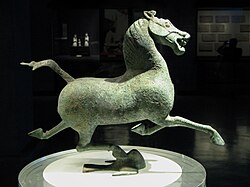
Nomads and Silk Road trade[edit]
Uzbekistan's first inhabitants were nomads who migrated out of Iran, and these early peoples thrived during the 1st Millennium BCE by building irrigation systems to grow crops.[7] Some of their settlements grew into significant cities like Samarkand and Bukhara, which emerged as centers of government and high culture.[8] As Imperial China started selling goods to the rest of the world along the Silk Road, these Central Asian cities became important and rich centers of commerce. A rarity for the time, the famously isolationist Chinese imported something from the region: the prized and specially bred Ferghana horses from the Ferghana Valley (where Tashkent is today).[9]
It wasn't all cash money and sunshine, though. The region's wealth made it a coveted prize for conquerors across Asia, and its inhabitants frequently had to fend off warlords and invaders. The Chinese, especially the Tang dynasty, also liked going to war in the region to get more Ferghana horses. One such warlord, Alexander the Great, successfully claimed the area for his Macedonian Empire in 328 BCE.[7] Unfortunately for him, he died, and his empire fractured among his successors. Sorry, bro.
During this time, religions like Zoroastrianism, Buddhism, and even eastern Christianity became influential here.[7] Persian culture also heavily influenced Uzbekistan, as it remained a province of Persia for many centuries.
Islamic golden age[edit]
.jpg)
After Muhammad united the various Arab tribes under Islam, the prophet's followers embarked on a rampage of conquest across much of the Middle East. Their initial targets were the traditional Holy Land of Palestine, Turkey, and Egypt, but Persia was on the menu. The Sasanian Empire, which ruled the roost in Persia at this point, had been weakened by decades of war with the Byzantine Empire, just to the point where it couldn't effectively resist the invaders.[10] It turns out that constant wars are stupid. Who knew?
The Muslims generally took a gradualist approach to convert people to Islam by offering incentives, although they also burnt many Zoroastrian texts to speed the process along.[11] The gradualist strategy also meant that the Arab rulers tolerated and eventually adopted many aspects of Persian culture. Central Asians finally supported the Abbasid dynasty in taking the caliphate during the inevitable political disputes over Islamic leadership. During the Abbasid era, Uzbekistan saw its golden age of prosperity and political importance.[12] Alongside Baghdad and Cordoba, the Uzbek city of Bukhara was one of the Muslim world's leading centers of learning, culture, and art.[13]
However, Turkic nomads to the north grew jealous of Uzbekistan's wealth. Of course, they did. In 999 AD, the Karakhanids and Ghaznavids stormed the region. However, they valued Uzbekistan's urban centers and thus refrained from totally destroying the cities,[12] unlike certain people we will soon get to. The Seljuks then rose to power here and used the region as a base from which to crush the Byzantine Empire and conquer Turkey for the Turks.
Mongol catastrophes[edit]
.jpeg)
“”I am the punishment of God. If you had not committed great sins, God would not have sent a punishment like me upon you.
|
| —Genghis Khan from Bukhara's main mosque.[14] One of history's most badass boasts. |
The Mongol invasion of Central Asia is one of the turning points in the history of the entire region. Beginning in 1219, Mongol hordes smashed in from the east, fueled mainly by Turkic soldiers Genghis Khan had recruited along the way.[15] Originally, Genghis apparently only wanted to establish trade relations favorable to himself. Still, word of his earlier atrocities had arrived, and local rulers scorned him after hearing tales of mass suicides and piles of human bones.[14] Genghis Khan was enraged by this refusal to deal with him, and he sent his armies in along with sophisticated siege equipment to start destroying and slaughtering the region's great cities. In 1220, he arrived at Bukhara, with a population of around 300,000.[14] The city fell quickly, and its people were either forced into the landscape with nothing or else were slaughtered where they hid. The prisoners Genghis Khan took from Bukhara he force marched in front of his armies on the approach to Samarkand, and he then used them as cannon fodder to protect his armies from the city's defenses.[14] Goddamn. Then he had Samarkand destroyed too. Goddamn. Once great cities like Samarkand, Bukhara, and others like Otrar and Urgench were left as ghost towns marked by pyramids of human skulls.[16] Goddamn.
The Mongol conquests also had the effect of greatly speeding along the Turkification of Uzbekistan. Many of Genghis Khan's footsoldiers were Turks, and they settled in the region to intermingle with the survivors of the Mongol fury.[15] It also helped that many of the old Persian-cultured people were, y'know, dead. Luckily for them, the Pax Mongolica set in, meaning that the Mongol holdings generally remained in peace, and the Silk Road was allowed to flourish as it was now mostly under one ruler. However, that luck eventually ran out.
The Timurids[edit]
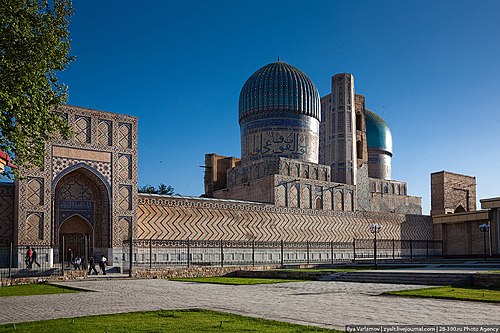
“”It has been noted that the Jenghiz-Khanite Mongol invasion of the thirteenth century was less cruel, for the Mongols were mere barbarians who killed simply because for centuries this had been the instinctive behavior of nomad herdsmen toward sedentary farmers. To this ferocity Tamerlane [Timur] added a taste for religious murder. He killed from Qur'anic piety. He represents a synthesis, probably unprecedented in history, of Mongol barbarity and Muslim fanaticism, and symbolizes that advanced form of primitive slaughter which is murder committed for the sake of an abstract ideology, as a duty and a sacred mission.
|
| —René Grousset, The Empire of the Steppes.[17] |
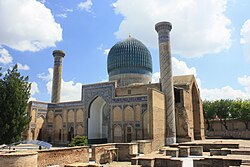
By the 1300s, the Mongol Empire started to break up amid infighting over succession. During the 1380s, Turko-Mongol warlord Timur Lenk (also known as "Tamerlane") came to prominence in his conquered capital, Samarkand. With his armies, he led a reign of terror over southern Asia while calling himself the "defender of Islam", committing genocides against Indian Hindus, Egyptian and Turkish "usurpers", and Middle Eastern Christians.[18][19] Timur also hit Baghdad again, having 90,000 people beheaded there so he could build towers with their skulls.[20]
After conquering a nice chunk of Asia, Timur started improving Samarkand. He brought back artisans from the conquered lands and set them to work building structures across his capital. He also allowed the city to become a new hub of intellectual and scientific development.[21] This era was called the Timurid Renaissance, a revival of the decades-dead Islamic Golden Age. It coincided with the Renaissance in Europe and is considered equal in glory.[22] Other parts of the empire, especially the city of Herat in Afghanistan, also benefited from the revival. It significantly influenced the development of the Ottoman Empire and the Mughal Empire, which rose in India. The Timurid era, however, marked the end of Uzbekistan's heyday and the beginning of its long slide into poverty and further brutality.
Long decline[edit]
Eventually, the consequences of all of this violence started to set in (consequences always do) and impact Central Asia. By the 1500s, the Timurid Empire dissolved into the same dynastic violence that had killed the Mongol Empire before it, and much smaller Uzbek tribal khanates seized control of the region in their stead.[21] The three most powerful were the Khanate of Bukhara, the Khanate of Khiva, and the Khanate of Kokand in the Ferghana Valley. The others were basically irrelevant.
The rise of the zealous Shia-following Safavid dynasty in Iran was one of the worst things that could have happened to the Uzbeks, as the Safavids considered the Sunni khans enemies and did their best to isolate Central Asia from the developments of the rest of the world.[21] Iran had been Uzbekistan's gateway to the world and was now closed. Not good. The Silk Road, for centuries the lifeblood of the region, also started to dry up because European colonial ventures from countries like Portugal and the Netherlands enhanced the value of overseas trade routes instead of overland ones. Also, not good. Urban life declined, and the Uzbeks reverted to nomadism, banditry, and hunting for slaves. A 1740 war against Nadir Shah of Persia proved the Uzbek decline decisively when the Uzbeks were slaughtered by Persian artillery.
Russian rule[edit]
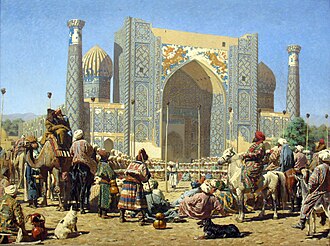
War and conquest[edit]
“”The position of Russia in Central Asia is that of all civilized states which are brought into contact with half-savage nomad populations possessing no fixed social organization.
|
| —Russian Foreign Minister Gorkachev justifies imperialism, 1854.[23] |
Uzbekistan's banditry and slave-raiding problem became so bad that the Khan of Khiva asked Peter the Great of Russia for help, offering to become a Russian subject in exchange. The Russians were very slow to respond, though, and they arrived many years later in 1717 to find that the khan had solved his problems on his own and had taken the offer off the table.[23] The khan had the roughly 4,000 Russian soldiers slaughtered as a show of his disapproval, which kicked off decades of war between Russia's frontiersmen and the Uzbeks. Especially distressing to the Russians was the Uzbek habit of kidnapping thousands of Russian settlers and selling them all into slavery.[23]
The slow Russian march into Central Asia turned into a colonialist race against the British Empire, which pushed north out of India. Meanwhile, Bukhara, Khiva, and Kokand constantly warred against each other, unable to put their petty rivalries aside in the face of a much more dangerous enemy.[24]
Ultimately, the American Civil War pushed things to the brink, as the American South could no longer provide the world with cotton due to the Union blockade. In search of a new source of cotton, the Russians decided to push south into Central Asia, where the climate was also suitable for cotton growth.[25] Relatively soon after this decision was realized, the Russians managed to take Tashkent, Bukhara, and Samarkand. By 1876, the entirety of Uzbekistan was directly owned by the Russian Empire or forced into protectorate status.
Modernization and secularization[edit]
_(14574343878).jpg)
Russian rule was initially fairly unimportant to the daily life of Uzbeks. Apart from introducing industrial methods of agriculture to boost cotton production, the Russians didn't do much to force their rule upon Uzbekistan.[25] The increased emphasis on cotton production did, however, create a new middle class in Uzbekistan due to the increased economic activity and concentration of agriculture.
Probably the most significant early impact of Russian rule here was secularism. Once a fundamentalist hotbed, Uzbekistan started to see a dramatic shift in its religious landscape as its people had to come to terms with the fact that Christian infidels had completely trounced them in war.[23] Over the next few decades, this gradually led to the rise of "Jadidism", a Muslim modernist movement notable for its anti-clericalism, emphasis on secularizing education, and desire to see Central Asian culture preserved.[26][27] Jadidism faced resistance from conservative Uzbek elites and the Russian overlords, who feared the movement's nationalistic component.
As the 1900s began, Russia expanded its modernization efforts for Uzbekistan by building more railways to efficiently ship cotton out of the province. Uzbekistan also started to feel the impact of Russia's reliance on a single cash crop there, as cultivation of food crops declined dramatically in favor of cotton.[25] This wasn't immediately catastrophic, but it did have a severe impact during later events. Large numbers of ethnic Russians also started moving into the region, attracted by the relatively warm climate and available land, and this began to result in a cultural connection.[28]
Struggle for independence[edit]
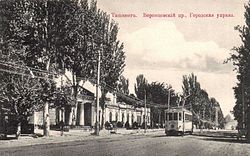
World War I was the tipping point where Uzbekistan again turned against the Russian government. Facing heavy losses on the front, the Tsar issued a decree in 1916 that made Central Asians available for conscription. The Uzbeks and the other Central Asian peoples weren't too interested in getting mowed down in a war that had nothing to do with them, and the Russian efforts to force them to comply became increasingly violent.[29] Resistance turned into an outright mutiny in Kyrgyzstan and Kazakhstan, where the locals were already pissed off at the government for confiscating their grazing land.
This mutiny became the Basmachi movement, and after the February Revolution, it evolved into a broader struggle for independence. In the Uzbek city of Tashkent, however, communists established a soviet council of their own, but it proved unpopular since it had almost no ethnic Uzbeks in its leadership.[30] Instead of relying on the soviet for representation, most Muslims threw in with the Basmachi, turning it into a region-wide guerrilla movement fighting against both factions in the Russian Civil War. The Red Army quickly moved in to crush them after dealing with anti-Bolshevik forces in the south, and one of their first actions was to massacre about 25,000 people in the city of Kokand.[31]
The Reds eventually realized that force wouldn't stop the revolt, and they negotiated with the leaders to promise local political autonomy and respect for their religion and culture.[29] By around 1922, this managed to defuse much of the guerrilla activity, although more stubborn Uzbeks persisted in fighting for about a decade afterward.
Soviet rule[edit]
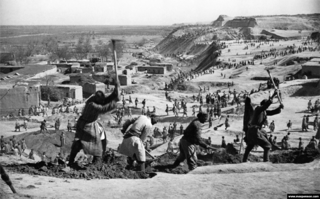
Stalinist abuses[edit]
Under Vladimir Lenin and after the implementation of his New Economic Policy, large numbers of Uzbeks felt comfortable enough to join the ruling party of the Soviet Union and join the political process of Uzbekistan.[29] This was aided significantly because many early communist policies were also supported to at least some extent by the Jadidis, including women's emancipation, land redistribution, and mass literacy campaigns.
Then things got bad again.
After Joseph Stalin came to power, he immediately reneged on the old Bolshevik promises made to Central Asia. His murderous paranoia fixated on the Central Asian Soviet republics, having Uzbek leader Fayzulla Khodzhayev and many other prominent Uzbeks executed en masse during the Great Purge.[33] Stalin then replaced the Uzbeks with Russians, largely excluding Uzbeks from the political process once more. Stalin also greatly emphasized cotton production, completing the process of turning Uzbekistan into a giant plantation. Stalin also liked to deport people into Uzbekistan whom he didn't want hanging around in Russia proper, mainly ethnic minorities and Muslims.[34]
Despite this abuse, the Uzbek people rallied to protect the Soviet Union during World War II. As many as 263,005 Uzbek soldiers died on the battlefields of the Eastern Front.[35] Others still who decided that they hated the Soviets more than the Nazis and chose to join Nazi Germany's Turkistanische Legion.[36]
Russification and tribalism[edit]
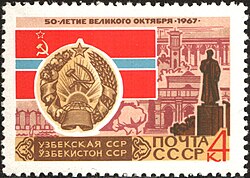
Luckily, Stalin died. Phew. His successor, Nikita Khrushchev, was a lot less of a bastard. He allowed more Uzbeks to join the government and ensured they did so on Russian terms. This meant a policy of "Russification", as learning the Russian language and abandoning most aspects of Uzbek culture were prerequisites for gaining prominence in the Communist Party.[37] This careful selection of Uzbek officials quickly turned Uzbekistan into one of the most politically conservative places in the entire Soviet Union.
Meanwhile, Uzbeks in power quickly leveraged that power to help their friends. People like Sharaf Rashidov, the first secretary of the Communist Party of Uzbekistan from 1959 to 1982, would do their best to ensure that the benefits of Soviet governance went primarily to their clans, regions, and families.[37]
Cottongate[edit]
.jpg)
“”According to a commonly told joke during this time period, a Soviet official asks a farmer how much cotton was grown. The farmer responds, "Enough to pile up to Allah’s feet." The official berates him for believing in a god, shouting, "There is no God!" The farmer responds, "That’s okay because there is no cotton either."
|
| —Kristen Traugh, Growing America.[38] |
The most prominent political issue in Uzbekistan became the rapidly rising cotton quotas demanded by Moscow; central planners hoped to offset the stagnation of the Soviet economy by increasing the production of raw materials.[39] The demands soon became nearly impossible, even with officials pulling kids out of schools to work the fields. Thanks to leader Rashidov's corruption, Uzbek officials just lied about meeting the quotas while patting each other on the back. Uzbek officials would send empty railcars to Moscow and bribe people to say nothing about it. Evidence suggests investigators may have been assassinated to keep it all secret.[38] The lies didn't make it any easier on the Uzbek people, however, as they were still required to pick 129-154 pounds per day and were paid about $0.09 per 2.2 pounds.[38] It's just that Uzbek officials lied and said there was even more.
The birds eventually came home to roost, although Rashidov was lucky enough to be dead by this point. "The Great Soviet Cotton Scandal" rocked the Soviet Union in the late 1970s and 1980s as the government abruptly realized that it was being defrauded to billions of rubles. Meanwhile, a few thousand Uzbek and Russian officials lived like kings. The Soviet authorities spent ages purging their government of everyone involved in the scandal. Even Soviet leader Leonid Brezhnev's son-in-law got sentenced to 12 years in a labor camp in connection to what the New York Times snarkily called "the Soviet Union's Watergate".[40] Just another shitty chapter in cotton's shitty history.
Environmental calamities[edit]
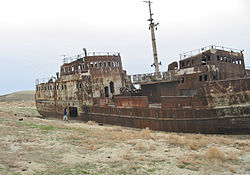
Uzbekistan once had a varied and bountiful natural environment. Unfortunately, decades of Soviet neglect and abuse fucked it all up. The Soviet Union's heavy use of agrochemicals, diversion of vast amounts of irrigation water from the two rivers that feed the region, and the chronic lack of water treatment plants caused health and environmental hazards on a truly horrifying scale.[41]
The worst catastrophe by far was the Aral Sea. Soviet authorities diverted the rivers Amu Darya and Syrdariya for cotton cultivation, meaning that the Aral Sea lost its primary water intake.[41] As a result, the Aral Sea started fucking disappearing. In 2010, UN Secretary-General Ban Ki-moon called it "one of the planet’s worst environmental disasters".[42] Where once was a body of water providing fish and transportation, there is instead a desert polluted by agrochemicals and even blowoff from biological weapons tests.[42] Jeez.
However, the Aral Sea disaster is only the most visible indicator of environmental decay. Decades of misusing pesticides and defoliants and the Soviet Union's general negligence in building sewage and water treatment plants have left the entire region in a toxic water crisis.[41] Additionally, decades of neglect in crop rotation in favor of just pounding out a single cash crop has destroyed the region's soil fertility and resulted in declining food production.[43] Blowoff from the Aral desert creates toxic dust storms because the situation wasn't shitty enough.
Race and resentment[edit]

After the cotton fiasco, Uzbekistan became synonymous in the Soviet Union with corruption and incompetence. Uzbeks resented that poor reputation since they felt that they had been unfairly singled out by Moscow; they were right since many Russians had been involved in the scandal, as well as people from other Central Asian republics. It was around this point that Uzbekistan's loyalty to Moscow began waning.
Meanwhile, Mikhail Gorbachev came to power and began his efforts to reform the stagnant Soviet Union. Part of these reforms involved loosening the central screws on Uzbekistan. In 1989, though, it became clear that this might not have been the best thing to do since the Uzbek people almost immediately responded by launching a bunch of race riots against Meskhetian Turks that killed hundreds of people.[44] The other Soviet republics also began experiencing ethnic turbulence (looking at you, Armenia, Azerbaijan, Tajikistan...).
The Gorbachev reforms also increased government honesty, and Uzbeks realized that the Soviet government had destroyed their republic's natural environment while exploiting their economy and labor. This pissed a bunch of people off, as you can imagine. Gorbachev's government responded to this unrest by appointing an ethnic Uzbek to lead the republic, a man named Islam Karimov.[45]
Independence[edit]
.jpg)
Like the other Central Asian Soviet republics, Uzbekistan was reluctant to push for independence from the Soviet Union due to concerns that its economy would be unable to support itself without help from the other Soviet republics. The August 1991 hardliner coup against Gorbachev pushed things to the brink, however, as the Supreme Soviet of Uzbekistan voted to begin a transition to independence rather than remain loyal to a clearly doomed government.[46] An independence referendum approved shortly afterward passed with 98.2% of the popular vote. Soon after the republic's official independence, it elected a new parliament and appointed Islam Karimov its president. During the first presidential election, however, Karimov won easily with 86% of the vote, and foreign observers noted that the election results were likely fudged.[47]
Karimov regime: torture and US alliance[edit]
“”The Uzbek regime’s use of boiling and other torture techniques has been well documented, and it is hardly a 'thing of the past,' as the State Department official asserted at the briefing. The State Department’s own human rights report on Uzbekistan for 2010 noted that 'torture and abuse were common' and cited allegations involving a range of sadistic methods: 'Guards routinely raped the prisoners with a club, subjected prisoners to enemas with red pepper solutions, and beat their heels until they bled.'
|
| —Susan Corke, Senior Program Manager for Eurasia at Freedom House, 2011.[48] |
Islam Karimov soon proved to be just another tinpot Central Asian post-Soviet dictator. His regime was one of the most oppressive in the entire region, imprisoning tens of thousands of political prisoners in a push to eliminate independent religious groups while using the whole Uzbek population as a source of forced labor for cotton production.[49] Like its neighbor Turkmenistan, Uzbekistan made cash for its elite class by forcing the citizenry, including schoolchildren, to work for almost no pay in the cotton fields for much of the year.[50]
However, Karimov's most infamous trait was his fondness for using torture on political prisoners. His regime opened Jaslyk prison, known as the "House of Torture", to inflict hideous punishments on people, including boiling alive, electric shocks, sexual assault, pulling fingernails, denial of food and water, and solitary confinement in small iron boxes.[51] Those who died would have their bodies returned to their families so that people would be terrified by the horrifying sight of the corpses' scars from torture.

When the Uzbek people were brave enough to protest against him, Karimov had state security forces gun them down. In May 2005, troops surrounded and fired on an anti-government demonstration in the southern city of Andijan, possibly killing up to 1,000 people.[49]
Karimov also went after dissidents abroad. In 2007, he had Alisher Saipov, a former reporter for Voice of America and the Moscow-based Ferghana.ru news website, gunned down execution-style in Kyrgyzstan.[49]
Karimov claimed he was fighting against Islamic extremism to justify his reign of terror.[52] At the time of the worst abuses, George W. Bush was in the White House and tended to view Karimov as an ally in the War on Terror.[53] The US even had a military base on Uzbek soil to help in the Afghanistan War. Fuck. Even Barack Obama's administration maintained close ties with Karimov's regime while the brutal dictatorship got worse.[54] In fact, Obama was just as much of a friend to Karimov as Bush was. In 2015, Obama's administration gave Karimov the largest military donation the United States has ever bestowed on a Central Asian country, including 300 Mine-Resistant Ambush Protected (MRAP) vehicles and 20 Armored Recovery Vehicles (ARV).[55] Hundreds of millions of dollars, basically, all given in dissident-crushing equipment for a dissident-crushing dictator.
The good thing is that Karimov died in 2016. The bad thing is that one of the Obama White House's last acts was issuing a public statement expressing that the US would remain committed to partnership with Uzbekistan.[56] At the very least, there wasn't any expression of sorrow.
Mirziyoyev regime[edit]
.jpg)
After Karimov died (a good candidate for Hell, assuming such a place exists), his understudy Shavkat Mirziyoyev took power in yet another suspicious presidential election. After taking power, he promised the rule of law, transparency, and greater engagement with the world.[57] Instead, the only significant change was Mirziyoyev opening Uzbekistan to foreign investment to get its economy out of the toilet. While the new president released some political prisoners as a media stunt, abuses such as torture and crackdowns on political freedoms remain unabated.[58] And even if the new Uzbek regime were to loosen up on its awfulness, there's still the problem that it remains an autocratic dictatorship and has shown no signs that it's willing to change that anytime soon.
Islam Karimov's daughter, meanwhile, remains in jail after having been put there by her father.[59]
Western observers often compare Mirziyoyev to Deng Xiaoping due to the two leaders' shared aims of improving the economies of long-isolated dictatorships.[60] The comparison is highly ominous due to Deng's responsibility for the Tiananmen Square Massacre.
Like the Bush and Obama administrations, Donald Trump's foreign policy team prioritized keeping on Mirziyoyev's good side. Mirziyoyev was invited to the White House in 2018, and Secretary of State Mike Pompeo traveled to Uzbekistan in 2020. These foreign diplomacy efforts seem aimed at helping Uzbekistan realize its ambitions of becoming a regional power in Central Asia and opening trade relations with other countries.[61] Despite Uzbekistan's torture problem worsening significantly in 2018 from the years before,[62] Pompeo still talked about how Mirziyoyev has supposedly turned Uzbekistan into a "more free and open society".[63] One possible motive? China. Pompeo's visit to Uzbekistan occurred within a larger tour across Asia to rally nations against the threat of Chinese power.[64] Uzbekistan, the country with its prisoners raped and beaten and its citizens used as slave labor, seems set to be a US friend for the foreseeable future.
Human rights[edit]
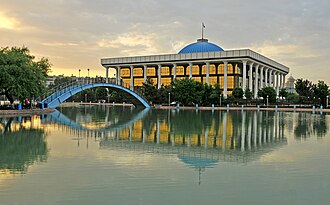
Torture[edit]
Uzbekistan is infamous for its inventive and hideously cruel torture methods against its prisoners (just look at the rest of the page!) This record has not gotten better under its new "reformist" president. Instead, the UN found that "complaints of torture received by the prosecutor’s office increased tenfold from 2017 to 2018" and that prosecutions for torture remain unknown.[62] Although Mirziyoyev has at least required that torture be revealed to Uzbek courts by authorities, judges still steadfastly ignore that many confessions are tainted by torture. Torture is used even against high-profile prisoners. Uzbekistan's former chief prosecutor, Rashitjon Kadirov, went on a months-long trial for alleged corruption and endured many rounds of torture to extract confessions of wrongdoing.[65] The UN has found that the new president's policies against torture have done little to dent the culture of impunity that torture and sexual violence in prisons enjoys.[66]
Freedom of expression[edit]
Uzbekistan has also done almost nothing to loosen free speech restrictions. Censorship is still routine, featuring intimidation tactics from state security forces and prosecutions of journalists and other government critics who peacefully express critical views.[67] Critics of the government are most frequently brought up on vague "extremism" charges which attempt to tie peaceful activists to Islamic extremism.
Slavery[edit]
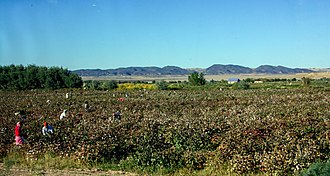
During the harvest season, the Uzbekistan government requires the nation's government employees, professionals, and schoolchildren to harvest the government's cotton fields. Anti-Slavery International disapproves. According to the 2016 Global Slavery Index, an estimated 1,236,600 people, or 3.97% of the population, are enslaved in modern-day Uzbekistan.[68][69]
Mirziyoyev has also made little progress here, either. The central government continues to be involved in mobilizing employees of public institutions and enterprises to work on cotton farms, with the fear of job or benefit loss or other reprisals if they refuse.[70] Cotton farmers face penalties and threats for failing to meet production quotas. Uzbekistan frequently attempts to convince the rest of the world to drop an ongoing boycott against Uzbek slave-labor cotton. However, human rights groups say that progress against slavery has been too little and too slow to see the boycott ended.[71]
LGBT rights[edit]
Alongside Turkmenistan, Uzbekistan is the only other post-Soviet state where homosexuality is a crime. In Uzbekistan, the "crime" carries a mandatory sentence of three to five years.[72] Hate crimes against LGBT people are disturbingly common and often posted online to a positive reaction. In August 2019, Istanbul-based LGBT activist Shohruh Salimov and other activists sent a public appeal to President Mirziyoyev, asking him to scrap anti-gay laws and protect LGBT lives. Instead, police harassed Salimov's relatives in Uzbekistan and publicly expressed a desire to see him arrested and punished.[72]
Inside Uzbekistan, LGBT activism is almost nonexistent, thanks to an atmosphere of fear in which anti-homosexuality charges are used to blackmail and threaten people into silence.[73]
Environment[edit]
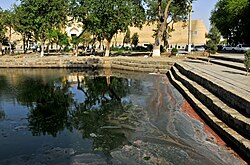
Thanks to the legacy of Soviet rule and the negligence of its dictatorship, Uzbekistan has a critically damaged natural environment. The Aral Sea is the most visible and damaging environmental disaster, which is still disappearing and has turned into a desert filled with toxic dust thanks to Soviet irrigation and pesticide policies.[42] This causes respiratory and other health problems for the millions of people who live near what was once a bountiful body of water.
Drinking water quality also is a major problem, especially in the western regions. Water sources are mainly contaminated with industrial chemicals or improper sewage treatment, devastatingly affecting on the local populations.[74] In fact, only about 40% of the Uzbek population even has access to sewage treatment systems. Yuck!
Soil contamination is highly severe due to the chronic overuse of pesticides and fertilizers. This results in decreasing agricultural yields, especially when combined with Uzbekistan's fixation on a single cash crop at the expense of proper crop rotation. Salt and dust storms related to the Aral Sea and the spraying of pesticides and defoliants for the cotton crop have led to severe degradation of air quality in rural areas.[74] The industrial activity also contributes to air pollution, especially in the Ferghana Valley.
All of these factors combine to produce an extremely adverse impact on human health for Uzbeks.
Gallery[edit]
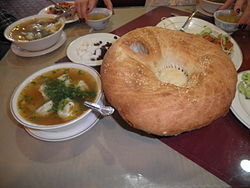
Uzbek dumpling soup and tandoor bread.
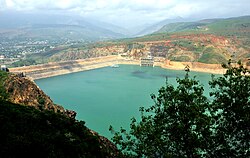
Charvak reservoir.
Bread-sellers in Urgut.
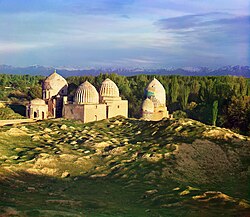
Shakh-i Zindeh mosque near Samarkand.
See also[edit]
- Herman Cain — the man who was able to reduplicate Uzbekistan more than anyone else
- Turkmenistan
Notes[edit]
- ↑ The Caspian Sea
 is just a lake that doesn't connect to the ocean, meaning Turkmenistan and Kazakhstan are landlocked.
is just a lake that doesn't connect to the ocean, meaning Turkmenistan and Kazakhstan are landlocked.
References[edit]
- ↑ Uzbekistan: Two Brutal Deaths in Custody. Human Rights Watch.
- ↑ The strange story of Uzbekistan’s 'jailed princess'
- ↑ Uzbekistan's autocratic ruler may have found a way to silence his daughter
- ↑ Suspected Gulnara Karimova letter smuggled to BBC
- ↑ See the Wikipedia article on United States–Uzbekistan relations § Military relations.
- ↑ See the Wikipedia article on Religion in Uzbekistan.
- ↑ 7.0 7.1 7.2 Uzbekistan: Early History. Country Studies.
- ↑ Lubin, Nancy (1997). "Uzbekistan", chapter 5 in: Glenn E. Curtis (Ed.), Kazakhstan, Kyrgyzstan, Tajikistan, Turkmenistan, and Uzbekistan: Country Studies. Washington, DC: Federal Research Division, Library of Congress. ISBN 0844409383. pp. 375–468: Early History, pp. 385–386.
- ↑ See the Wikipedia article on Ferghana horse.
- ↑ See the Wikipedia article on Muslim conquest of Persia.
- ↑ Milani A. Lost Wisdom. 2004 ISBN 978-0-934211-90-1 p.15
- ↑ 12.0 12.1 About Uzbekistan: Arrival of Islam. Uzbek Travel.
- ↑ Uzbekistan: The Early Islamic Period. Country Studies.
- ↑ 14.0 14.1 14.2 14.3 Facing the Wrath of the Khan. History Net.
- ↑ 15.0 15.1 Uzbekistan: The Mongol Period. Country Studies.
- ↑ About Uzbekistan: Mongol Avalanche. Uzbek Travel.
- ↑ Timur. Wikiquote.
- ↑ Tamerlane’s Reign of Terror History Answers UK
- ↑ 10 Terrors Of The Tyrant Tamerlane Listverse
- ↑ The Death of Tamerlane History Today
- ↑ 21.0 21.1 21.2 About Uzbekistan: Tamerlane Era. Uzbek Travel.
- ↑ Ruggiero, Guido (15 April 2008). A Companion to the Worlds of the Renaissance, Guido Ruggiero. ISBN 9780470751619.
- ↑ 23.0 23.1 23.2 23.3 About Uzbekistan: The Russians Arrive. Uzbek Travel.
- ↑ Uzbekistan: Arrival of the Russians. Country Studies.
- ↑ 25.0 25.1 25.2 Uzbekistan: The Russian Conquest. Country Studies.
- ↑ Khalid, Adeeb (1998). The Politics of Muslim Cultural Reform: Jadidism in Central Asia. Berkeley, CA: University of California Press. ISBN 978-0-520-21356-2.
- ↑ See the Wikipedia article on Jadid.
- ↑ Uzbekistan: Entering the Twentieth Century. Country Studies.
- ↑ 29.0 29.1 29.2 The Jadidists and Basmachis. Country Studies.
- ↑ See the Wikipedia article on Tashkent Soviet.
- ↑ Uzbekistan, By Thomas R McCray, Charles F Gritzner, pg. 30, 2004, ISBN 1438105517.
- ↑ The Forgotten Photographer Of Soviet Uzbekistan. Radio Free Europe.
- ↑ See the Wikipedia article on Fayzulla Khodzhayev.
- ↑ Uzbekistan: The Stalinist Period. Country Studies.
- ↑ Chahryar Adle, Madhavan K. Palat, Anara Tabyshalieva (2005). "Towards the Contemporary Period: From the Mid-nineteenth to the End of the Twentieth Century." UNESCO. p.232. ISBN 9231039857
- ↑ See the Wikipedia article on Turkestan Legion.
- ↑ 37.0 37.1 Uzbekistan: Rashidov. Country Studies.
- ↑ 38.0 38.1 38.2 The Great Soviet Cotton Scandal. Growing America.
- ↑ The Cotton Republic: Colonial Practices in Soviet Uzbekistan. Central Eurasian Studies Society.
- ↑ Brezhnev Son-in-Law Gets 12-Year Term. New York Times.
- ↑ 41.0 41.1 41.2 Uzbekistan: Environment. Country Studies.
- ↑ 42.0 42.1 42.2 How the Soviet Union Created Central Asia’s Worst Environmental Disaster. The Diplomat.
- ↑ Culture and Water: A host of Soviet Central Asia's environmental dilemmas stem from its limited supply of water. Cultural Survival.
- ↑ Ethnic Relations in Uzbekistan in the Soviet Era. Facts and Details.
- ↑ Uzbekistan: The 1980s. Country Studies.
- ↑ Uzbekistan: Independence. Country Studies.
- ↑ Armanini, A. J. (2002). Politics and Economics of Central Asia. Nova Publishers. p. 36. ISBN 9781590331828.
- ↑ Uzbekistan: So Now Prisoners are Frozen Instead of Boiled? Eurasia Net.
- ↑ 49.0 49.1 49.2 Uzbekistan buries dictator Karimov. Politico.
- ↑ U.N.'s Ban criticizes forced labor in Uzbek cotton fields. Reuters.
- ↑ Uzbekistan's 'House Of Torture'. Radio Free Europe.
- ↑ US looks away as new ally tortures Islamists. The Guardian.
- ↑ Uzbekistan: Bush Allies Seek Harsher U.S. Treatment Of Karimov. Radio Free Europe.
- ↑ America’s Uzbekistan Problem. New York Times.
- ↑ The Obama Administration Is Gifting War Machines to a Murderous Dictator. New Republic.
- ↑ Statement by the President on the Death of President Islom Karimov of Uzbekistan. Obama White House.
- ↑ Analysis: Will Uzbekistan's Champion of Reform Stay the Course? Voice of America.
- ↑ Reality Check on Human Rights in Uzbekistan. The Diplomat.
- ↑ Jailed daughter of late Uzbek leader says gave state $1.2 bn. France24.
- ↑ Eurasia's Latest Economic Reboot Can Be Found In Uzbekistan. Forbes.
- ↑ Secretary Pompeo’s Visit to Uzbekistan. US State Department.
- ↑ 62.0 62.1 Uzbekistan: Torture Widespread, Routine. Human Rights Watch.
- ↑ Pompeo Hails Uzbekistan's 'Progress' On Human Rights. Radio Free Europe.
- ↑ Pompeo Message in Europe, Central Asia Trip: Beware of China. Voice of America.
- ↑ Uzbekistan: Reports of Torture of Ex-Official. Human Rights Watch.
- ↑ Uzbekistan: UN Cites Concerns on Torture, Freedoms. Human Rights Watch.
- ↑ “You Can't See Them, but They’re Always There”: Censorship and Freedom of the Media in Uzbekistan. Human Rights Watch.
- ↑ Kevin Bales; et al. "Uzbekistan". The Global Slavery Index 2016. The Minderoo Foundation Pty Ltd. Retrieved 13 March 2018.
{{cite web}}: Explicit use of et al. in:|first1=(help) - ↑ Forced Cotton-Picking Earns Uzbekistan Shameful Spot In ‘Slavery Index’. May 31, 2016.
- ↑ Forced Labor Persists in Uzbekistan’s Cotton Fields. Human Rights Watch.
- ↑ Cotton Campaign says too early to lift Uzbek boycott. Reuters.
- ↑ 72.0 72.1 World Report 2020: Uzbekistan. Human Rights Watch.
- ↑ In Uzbekistan, homosexuality is illegal. Here's what LGBT life is like there. Open Democracy.
- ↑ 74.0 74.1 Environmental Issues in Uzbekistan. Facts and Details.
Categories: [Asian countries] [Authoritarian regimes] [Crimes against humanity] [Environment] [Homophobia] [Slavery]
↧ Download as ZWI file | Last modified: 11/05/2025 00:36:06 | 546 views
☰ Source: https://rationalwiki.org/wiki/Uzbekistan | License: CC BY-SA 3.0
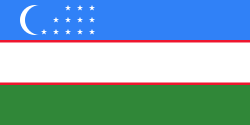

 KSF
KSF